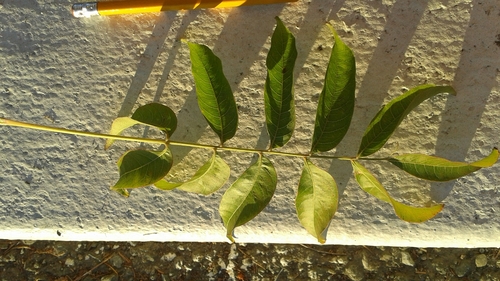Chinese pistache
Pistacia chinensisSummary 8
Pistacia chinensis (English: Chinese pistache; Chinese: 黄连木; pinyin: huángliánmù) is a small to medium-sized tree in the genus Pistacia in the cashew family, Anacardiaceae, native to central and western China. It is hardy, can withstand harsh conditions and poor quality soils, and grows up to 20 m. The leaves are deciduous, alternate, pinnate, 20–25 cm long, with 10 or 12 leaflets, the terminal leaflet usually absent. The flowers are produced in panicles 15–20 c
Description 9
It is hardy, can withstand harsh conditions and poor quality soi]s, and grows up to 20 m (66 ft). The leaves are deciduous, alternate, pinnate, 20–25 cm long, with 10 or 12 leaflets, the terminal leaflet usually absent. The flowers are produced in panicles 15–20 cm (5.9–7.9 in) long at the ends of the branches; it is dioecious, with separate male and female plants.
The fruit is a small red drupe, turning blue when ripe, containing a single seed.
Distribution and habitat 9
Its native range is on hill and mountain forests on rocky soils at 100–3,600 m (330–11,810 ft) above sea level. It is found in Mainland China (excluding the far north and the far west) and Taiwan.
Ecology 9
Chinese pistache grows best in full sun, being intolerant of shade; it is the most frost-tolerant species of Pistacia, tolerating temperatures down to about -25 °C, yet it is most highly regarded in warm climates. It is planted for its impressive fall colors, which develop at least as far south as Orlando, Florida. In the low-elevation deserts of Arizona, it is the only tree whose leaves turn scarlet in fall.
Uses 9
It is a popular choice for street trees in urban settings because it is very drought tolerant and can survive harsh environments. It is also used as an understock for Pistacia vera. In China, the oil from the seeds is used for biodiesel production. The wood is used for production of furniture, and yields a yellow dye.
It is also used in classical Chinese garden design.
Fontes e Créditos
- (c) 潘立傑 LiChieh Pan, alguns direitos reservados (CC BY-NC-SA), http://www.flickr.com/photos/68821308@N00/540364702
- (c) icosahedron, alguns direitos reservados (CC BY), enviado por icosahedron
- (c) Cullen Hanks, alguns direitos reservados (CC BY-NC), enviado por Cullen Hanks
- (c) Chris Cook, alguns direitos reservados (CC BY-NC), enviado por Chris Cook
- (c) Alan R Lusk, alguns direitos reservados (CC BY-NC), enviado por Alan R Lusk
- (c) c michael hogan, alguns direitos reservados (CC BY-NC-SA), enviado por c michael hogan
- (c) Christian Schwarz, alguns direitos reservados (CC BY-NC), enviado por Christian Schwarz
- Adaptado por Jeny Davis de uma obra de (c) Wikipedia, alguns direitos reservados (CC BY-SA), https://en.wikipedia.org/wiki/Pistacia_chinensis
- (c) Wikipedia, alguns direitos reservados (CC BY-SA), https://en.wikipedia.org/wiki/Pistacia_chinensis
Mais informações
- BioDiversity4All taxon page
- Atlas of Living Australia
- Biodiversity Heritage Library
- BOLD Systems BIN search
- Calflora
- CalPhotos
- eFloras.org
- Flora of North America (beta)
- Global Biodiversity Information Facility (GBIF)
- HOSTS - a Database of the World's Lepidopteran Hostplants
- IPNI (with links to POWO, WFO, and BHL)
- Jepson eFlora
- Maryland Biodiversity Project
- NatureServe Explorer 2.0
- New Zealand Plant Conservation Network
- SEINet Symbiota portals
- Tropicos
- USDA PLANTS database
- World Flora Online
- 日本のレッドデータ検索システム
- 植物和名−学名インデックス YList














